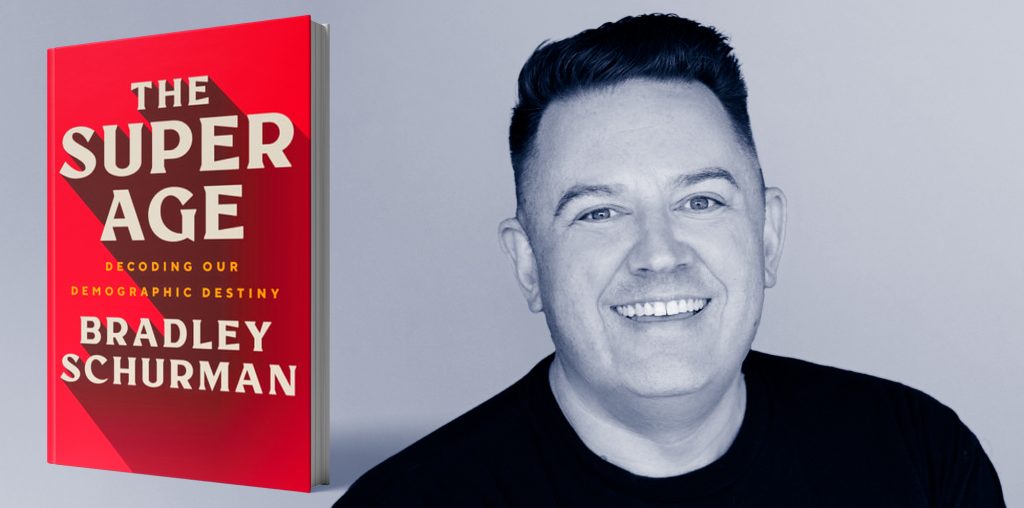Congratulations to Bradley Schurman for his pragmatic, thought provoking overview of ‘The super Age’ – this time in history when there are more older citizens than ever – but only one in seven companies is actively responding to this growing consumer force.
Bradley shared time this week to respond to our questions on why governments and companies need to sit up and take notice, now.
Ageing demographics are not new – nations around the globe have been experiencing this trend for decades now. So why do you believe now is the time to recognise and prepare for ‘the Super Age’?
The ageing of the population has been happening for over 200 years, beginning roughly around the beginning of the First Industrial Revolution (1760-1840). However, the speed of the transition accelerated following the end of the Second Industrial Revolution (1870-1914), and it’s now hurtling us into a novel period for humanity where one out of five people will be over the age of 65.
This is a seismic event, and one that nations can no longer ignore, especially since it is happening against the backdrop of precipitous decline in birth rates. Today, three quarters of G20 countries have birthrates which are below replacement rate. And, some countries like China and Japan, are already experiencing population decline.
It’s not so much preparing for the Super Age anymore. It’s adapting to the change that’s already here.
Can you offer a ‘back of envelope’ overview of The Super Age?
The Super Age is a three-part work of non-fiction that examines how we arrived at an older and more generationally diverse world – attitudes, innovation, etc. – what happens when we do nothing to adapt to this new reality, and the opportunities that exists if we lean into this novel era and uncover the potential of a population that is living longer and healthier lives than ever before. This book is not about old people.
And why should businesses get up to speed on this?
Business has always been a numbers game and today is no different. For most of the past century, and certainly for all of our lifetimes, companies have focused on selling to kids starting with the boomers and then moving on to Gen X, Millennials, and now Gen Z. The problem with this approach, where at one point 500 times more was spent on marketing to millennials than any other groups combined, is that it ignores demographic and economic realities. There are more older people today and fewer younger people. The map has shifted and businesses have to come to terms with that, if they are going to survive.
What has brought you to the discussion – what in your background means you are best placed to provide thought leadership?
I’ve spent nearly a quarter century examining demographic trends and reporting on innovations in the field. I started with LeadingAge, which is the US trade association representing non-profit ageing services, before joining AARP to help them develop their global ageing program. I stayed with AARP for 15 years before leaving in 2018 to launch my first start-up.
Can you share a brief futurist outlook for the three T’s – Travel, transport and technology?
This is a great time to innovate around all three T’s, but in order to do that all three sectors will need to be more generationally inclusive in their approach.
We’re going to see an explosion of the later life gap year, and a growing number of superagers will be engaging in experiential travel. However, we know that older populations have different needs and expectations within their accommodations, and that some are willing to spend a bit more for it too. Hotels, in particular, would be wise to consider how inclusive design can help them build spaces that work for nearly everyone.
Transport will continue its path towards automation. It will be driven by large public investments in 5G, in particular. Post-50 populations will continue to make up the lion’s share of the luxury car market and they will demand more features that help them retain their mobility.
The tech industry has an ageing problem – meaning that it tends to exclude older populations. That will need to change, especially if anti-age bias is being built into artificial intelligence today. Web3.0 and the metaverse are arriving quickly and some of the earliest adopters of VR tech, in particular, are the oldest who cannot leave their homes. I can see the metaverse offering us a new way to work, and potentially a new way to deliver care. Robots are already assisting with surgeries. Who says they couldn’t be in the home as helpers in the near future?
If you were a CEO of a company in one of these three sectors, how would you want your senior team to grasp this opportunity?
I point businesses to the data and then tell them what the data means. Approaching business as usual is just not good business anymore. And seeing older populations through the same tired lens is folly. Older populations today are healthier than ever before, they are better connected than ever before, they are cognitively fitter than ever before, AND they have more money than ever before. Businesses are always looking for emerging markets… All they need to do is look up to the older populations for new markets that also happen to be rich.

